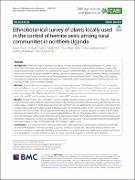| dc.contributor.author | Okori, Betty C. | |
| dc.contributor.author | Oryema, Christine | |
| dc.contributor.author | Opiro, Robert | |
| dc.contributor.author | Acur, Amos | |
| dc.contributor.author | Obici, Gilbert | |
| dc.contributor.author | Rutaro, Karlmax | |
| dc.contributor.author | Malinga, Geoffrey M. | |
| dc.contributor.author | Sande, Eric | |
| dc.date.accessioned | 2022-06-22T18:49:08Z | |
| dc.date.available | 2022-06-22T18:49:08Z | |
| dc.date.issued | 2022 | |
| dc.identifier.citation | Okori, B. C., Oryema, C., Opiro, R., Amos, A., Obici, G. I., Rutaro, K., ... & Sande, E. (2022). Ethnobotanical survey of plants locally used in the control of termite pests among rural communities in northern Uganda. CABI Agriculture and Bioscience, 3(1), 1-10. | en_US |
| dc.identifier.uri | https://doi.org/10.1186/s43170-022-00109-3 | |
| dc.identifier.uri | https://hdl.handle.net/123456789/416 | |
| dc.description.abstract | Background: Termites are the most destructive pests in many agricultural and forest plantations in Uganda. Current
control of termites mostly relies on chemical pesticides. However, the adverse effects of chemical insecticides
necessitate the need to search for and popularize the usage of environmentally safer options. Plants represent one of
the most accessible resources available for termite control by communities in Uganda. However, limited documented
information exists for their contribution in the management of except through verbal sharing. This study aimed at
assessing the communities’ knowledge about plants traditionally used in controlling termites among selected communities
in Apac District, northern Uganda.
Method: An ethnobotanical survey was conducted between November 2016 and February 2017 in 12 randomly
selected villages in the sub counties of Apac and Ibuje of Apac District, northern Uganda. Open-ended questionnaire
interviews were used to gather ethnobotanical and sociodemographic data. A total of 381 indigenous people were
interviewed [male, 281 (73.8); female, 100 (26.2)]. Data were analysed using descriptive statistics and Informant Consensus
Factor (ICF), and the relative frequency of citation (RFC) was determined.
Results: Overall, 70.9% of the respondents were knowledgeable about plants used for control of termites. There was
a significant association between respondents’ knowledge of pesticidal plants with age and gender but not with education
status. A total of 11 plant species belonging to eight families were identified to be in use for control of termites
in Apac. Solanaceae, Eurphorbiaceae and Asteraceae were the most represented families with two species each, while
the rest of the families had only one species mentioned. According to the relative frequency of citation (RFC), Kigelia
africana (Lam.) Benth. (RFC = 0.43), Vernonia amygdalina Delile (0.18) and Tithonia diversifolia (Hemsl.) A. Gray (0.10)
were the most used in the control of termites in the study area. Fruits (45.9%) and leaves (29.2%) were the most used
plant parts. Squeezing, crushing and chopping of the plant materials were the most popular methods of preparation
and water extract was the commonest mode of formulation of plant parts.
Conclusions: The study has shown that rural populations of the targeted localities possess indigenous knowledge
on anti-termitid plants. However, screening is urgently needed to validate their bioactivity and to determine the
bioactive constituents responsible for killing the invertebrates in pest management. Furthermore, simple methods for
local propagation and cultivation are needed to ensure a sustainable supply of termicidal plant biomass | en_US |
| dc.language.iso | en | en_US |
| dc.publisher | CABI Agriculture and Bioscience | en_US |
| dc.subject | Ethnobotanicals | en_US |
| dc.subject | Indigenous knowledge | en_US |
| dc.subject | Langi | en_US |
| dc.subject | Macrotermes | en_US |
| dc.title | Ethnobotanical survey of plants locally used in the control of termite pests among rural communities in northern Uganda | en_US |
| dc.type | Article | en_US |

